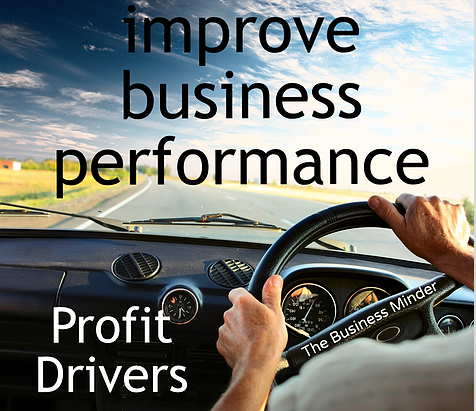How to outperform your competitors and improve your bottom line
- The Business Minder
- Feb 23, 2017
- 4 min read

How can you make a difference to the way your business performs and improve your bottom line? How can your business outperform your competitors? You may think that great financial results just happen, but its hardly the case. Businesses can get a good run but success usually comes from hard work and smart thinking. Reducing costs can improve your bottom line but not if those costs are necessary to run your business. Take a look at the Value Driver Concept. Compare these 3 strategies to better understand my point.
1. Decreasing variable costs
Businesses use key drivers for major cost efficiency items. This increases your margin but doesn't increase your overall revenue.
2. Reducing fixed costs (overheads)
This has no impact on your revenue and will always have the smallest impact
3. Sales Revenue
One of the most significant profit drivers is sales revenue or turnover. There are 3 simple factors that determine turnover for a business
Number of customers
Average number of transactions per customer each year
Average value of each transaction
When applied in marketing and sales key drivers can significantly boost your profitability because each Key 'Profit Driver' increase is Multiplied (not added) to every increase you achieve. By converting more enquiries into sales and leveraging more sales per customer, small increases in each of the 'Profit Drivers' have an enormous impact on your bottom line.
Value Drivers
These can be grouped into Financial and Operational.
Using Financial drivers
Determine where and how your business sources its capital and how you use it to finance your operations. Actively managing variables that impact your working capital or expenditure in fixed assets can create sustainable value in the medium and long term. If driving profit is why you are reading, you will want to focus on your pricing.
Here is a list of key financial drivers for most businesses
Profit
Number of Enquiries or sales leads
Sales per square meter (retail)
Increasing sales (turnover)
Conversions to Sales
Average Number of Transactions per customer
Average Value per Sale
Number of Times a Customer Buys from You
Gross Profit Margin per Sale
Hours sold per day
Costs
Reducing the cost of sales
Reducing overhead expenses
Buying or input prices
Production efficiency
Discounts
Working capital
Accounts receivable
Inventory
Prepaid balances in current assets and accounts payable
Other payables
Unearned income in the current liabilities
Inventory
Stock turnover rate (ratio of cost ofsales to stock)
Supplier turn arounds
Deliveries
Debt collection
Aged list of debtors (days outstanding)
Overdues
Conversions to direct debit
Look at the critical factors that drive your profitability and work relentlessly on those areas of your business. A whole range of internal and external factors affect the performance of every business. Pricing will always have an impact that is two or three times greater than any of the other drivers. An increase in price has the greatest impact because every additional dollar goes straight to profit. Don't allow price sensitive customers or competitors to dictate your pricing strategy. Price your products or services competitively. Do business with customers who see the value that you deliver to them. Your business profitability is your only measure of success. Revenue does not pay the bills or give you the resources you need to grow. That comes from profit.
Using Operational drivers
Operational drivers encompass all those variables that impact the cash generation capacity of your business either by boosting growth or increasing efficiency. At their most basic level, these drivers include revenues and costs and in turn all those variables that increase revenues and reduce costs (e.g. volume, price, etc.). You have a high degree of influence over these drivers. Managing them is a core part of your job. Most value drivers tend to be operational and the vast majority of resources your business has is spent on controlling them. Here are examples of key operational drivers for your business
Productivity e.g. machine downtime in a factory,
Client satisfaction
Quality of the product or service
Training of employees
Employee turnover
Employee satisfaction (morale)
Business culture and values
Product and process innovation
Market share
Employee safety
Operational drivers impact on your cash flow and how effective you are at controlling them. Sometimes a driver is so impactful that even if it cannot be controlled, just by managing its impact, you can actually add significant business value.
Use benchmarking
Use your historical figures as a benchmark for your current performance. Figures for last year and last month provide hard facts and established patterns for your business and identify potential problems and opportunities.
Getting Value Drivers to work for you
Identifying your key value drivers and acting on them are powerful tools. Value driven management aligns your operational and financial tactics with your long term strategy. It allows you to focus on what can be done today to create value in the future and adjust your course when needed.
The secret is to focus on setting around five key drivers and see how you go in year 1. Your drivers may change with time due to the growth of your business, changes in your market or seasonal changes. Meet with your accountant and The Business Minder can help you to identify the top five drivers for your business. Decide how often you need to monitor these drivers and what steps you can take to improve results.









































Comments